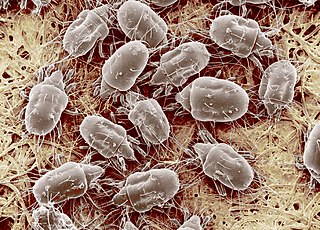
Varroa is a genus of parasitic mites associated with honey bees, placed in its own family, Varroidae. The genus was named for Marcus Terentius Varro, a Roman scholar and beekeeper. The condition of a honeybee colony being infested with Varroa mites is called varroosis.

The Acaridae are a family of mites. Common forms include some mold mites, for example the grain mite. Genera in the family include:

Histiostomatidae is a family of astigmatid mites and branches basically in a phylogenetic tree of the Astigmata.

Tyrophagus is a genus of mites in the family Acaridae.
The Macronyssidae are a family of parasitic mites in the order Mesostigmata.

The Laelapidae are a family of mites in the order Mesostigmata. The family is also referred to in the literature as Laelaptidae, which may be the correct spelling.
Horstia is a genus of mites in the family Acaridae.

Sancassania is a genus of mites in the family Acaridae that contains more than 80 different species.
Schwiebea is a genus of mites in the family Acaridae.
Viedebanttia is a genus of mites in the family Acaridae.

Macrochelidae is a family of mites in the order Mesostigmata, containing the following genera and species:

Pachylaelapidae is a family of mites in the order Mesostigmata.
Ameroseiidae is a family of mites in the order Mesostigmata.

Proctolaelaps is a genus of mites in the family Ascidae.

Parasitellus is a genus of mites in the family Parasitidae which are obligatory parasites of bumblebees. These mites can be found clinging to the carapace, sometimes in large numbers. Mites in this genus hibernate in the deutonymphal stage. In the tritonymph stage they can actively transfer from bumblebee to bumblebee from flowers, where they can survive up to 24 hours. After they arrive in a bumblebee nest, they will moult into adults. Whilst it is not known what factors trigger the mite to molt, in laboratory conditions P. fucorum were found to moult after eating fresh pollen, although overall moulting success was low. They are kleptoparasitic or neutral to beneficial, depending on life stage; females and deutonymphs feed on provisioned pollen, while other stages are predators of small arthropods.

Uroobovella is a large genus of mites in the family Urodinychidae.
Chaetodactylus is a genus of parasitic mite primarily associated with solitary bees with over 20 species.

Glycyphagidae is a family of mites in the order Astigmata. There are more than 25 genera and 100 described species in Glycyphagidae.

Chaetodactylus krombeini,, was described by Karl Krombein and E. W. Baker in the 1960s. The mites are about 0.5 mm across, with the females larger than the males. Pollen mites are a kleptoparasitic pest of Megachilid solitary bees, with Ch. krombeini found with Osmia lignaria of North America,. Pollen mites do not feed on bees, but rather their provisions, and are harmful because they consume the food resources and starve or stunt the developing larvae; there is evidence that pollen mites also directly harm the egg by puncturing it.

Roubikia is a genus of bee-associated mites occurring in the neotropics. They are mutualists or commensals, and feed on fatty acids from floral oils and most likely on fungi. The type species is Chaetodactylus panamensis.














